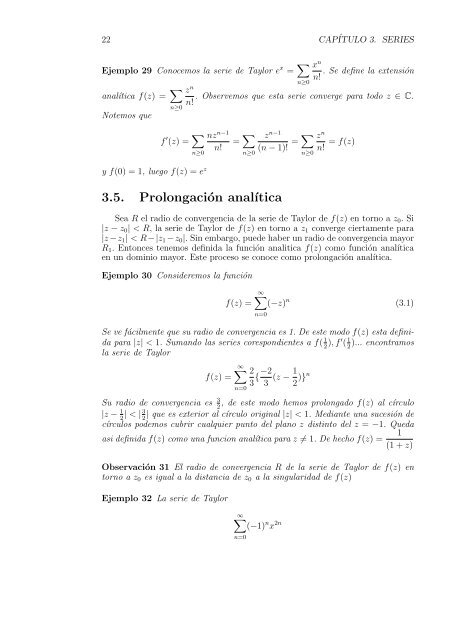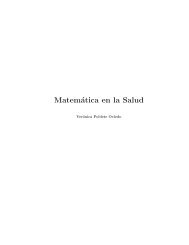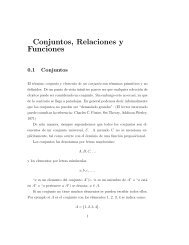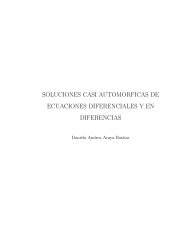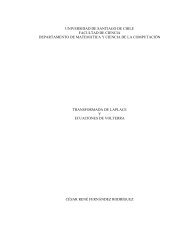Apuntes de Variable Compleja - Carlos Lizama homepage ...
Apuntes de Variable Compleja - Carlos Lizama homepage ...
Apuntes de Variable Compleja - Carlos Lizama homepage ...
You also want an ePaper? Increase the reach of your titles
YUMPU automatically turns print PDFs into web optimized ePapers that Google loves.
22 CAPÍTULO 3. SERIES<br />
Ejemplo 29 Conocemos la serie <strong>de</strong> Taylor e x = <br />
analítica f(z) = <br />
Notemos que<br />
n≥0<br />
n≥0<br />
xn . Se <strong>de</strong>fine la extensión<br />
n!<br />
zn . Observemos que esta serie converge para todo z ∈ C.<br />
n!<br />
f ′ (z) = nzn−1 z<br />
=<br />
n! n−1<br />
(n − 1)!<br />
n≥0<br />
y f(0) = 1, luego f(z) = e z<br />
n≥0<br />
3.5. Prolongación analítica<br />
= <br />
n≥0<br />
z n<br />
n!<br />
= f(z)<br />
Sea R el radio <strong>de</strong> convergencia <strong>de</strong> la serie <strong>de</strong> Taylor <strong>de</strong> f(z) en torno a z0. Si<br />
|z − z0| < R, la serie <strong>de</strong> Taylor <strong>de</strong> f(z) en torno a z1 converge ciertamente para<br />
|z −z1| < R−|z1 −z0|. Sin embargo, pue<strong>de</strong> haber un radio <strong>de</strong> convergencia mayor<br />
R1. Entonces tenemos <strong>de</strong>finida la función analitica f(z) como función analítica<br />
en un dominio mayor. Este proceso se conoce como prolongación analítica.<br />
Ejemplo 30 Consi<strong>de</strong>remos la función<br />
f(z) =<br />
∞<br />
(−z) n<br />
n=0<br />
(3.1)<br />
Se ve fácilmente que su radio <strong>de</strong> convergencia es 1. De este modo f(z) esta <strong>de</strong>finida<br />
para |z| < 1. Sumando las series corespondientes a f( 1<br />
2 ), f ′ ( 1)...<br />
encontramos<br />
2<br />
la serie <strong>de</strong> Taylor<br />
∞ 2<br />
f(z) =<br />
3 {−2<br />
1<br />
(z −<br />
3 2 )}n<br />
n=0<br />
Su radio <strong>de</strong> convergencia es 3,<br />
<strong>de</strong> este modo hemos prolongado f(z) al círculo<br />
2<br />
|z − 1 3 | < | | que es exterior al círculo original |z| < 1. Mediante una sucesión <strong>de</strong><br />
2 2<br />
círculos po<strong>de</strong>mos cubrir cualquier punto <strong>de</strong>l plano z distinto <strong>de</strong>l z = −1. Queda<br />
1<br />
asi <strong>de</strong>finida f(z) como una funcion analítica para z = 1. De hecho f(z) =<br />
(1 + z)<br />
Observación 31 El radio <strong>de</strong> convergencia R <strong>de</strong> la serie <strong>de</strong> Taylor <strong>de</strong> f(z) en<br />
torno a z0 es igual a la distancia <strong>de</strong> z0 a la singularidad <strong>de</strong> f(z)<br />
Ejemplo 32 La serie <strong>de</strong> Taylor<br />
∞<br />
n=0<br />
(−1) n x 2n


